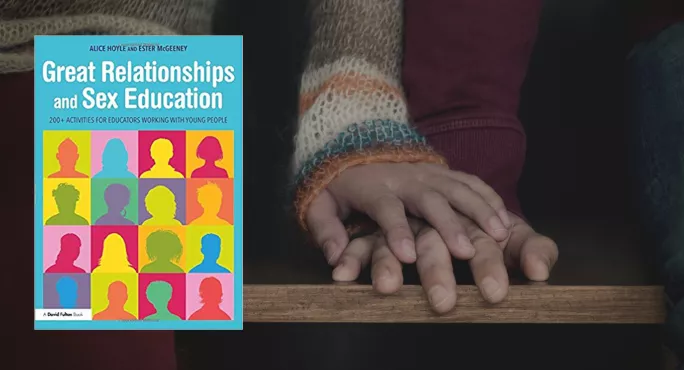- Home
- Book review: Great Relationships and Sex Education
Book review: Great Relationships and Sex Education

Great Relationships and Sex Education: 200+ activities for educators working with young people
Authors: Alice Hoyle and Ester McGeeney
Publisher: Routledge
Details: 368pp; £35.00
ISBN: 978-0815393634
There are a vast number of tasks in Great Relationships and Sex Education, so every teacher should be able to find one that fits their skills and what they are comfortable delivering.
There are verbal tasks, role-play tasks, card-sorting activities and visuals to explain even the most awkward topics.
There’s age guidance and a time frame for each one. There are also tasks for most age groups, though it does feel secondary-heavy.
Sex education content
On first starting the book, I must admit that I did feel overwhelmed. I became acutely aware that teachers won’t have time to deliver one-tenth of the content or have the confidence to cover some of the topics.
Spending an hour discussing sexual responses and arousal is not feasible when most schools have an hour to cover sexually transmitted infections, contraception and consent.
The second time I picked up the book, however, I used the index at the front. Using it this way, and dipping into the topics, was far less daunting.
I quickly found and photocopied several sheets for the recent internet-safety week. I covered sections with Post-it notes to look at later.
I soon realised that this will become one of those books on every PSHE teacher’s shelf that ends up with a multitude of multicoloured tabs poking out.
The second half of the book is better than the first. It is more focused on facts, something which is probably more useful to PSHE teachers, considering the time constraints that they are under.
Creating safe spaces
The terminology page is well-structured, and specifically handy for parts of the body. There is a lot of debate around this issue: about being inclusive, and about not making assumptions about what body parts someone has based on their appearance or gender identity.
The authors openly admit that they found this chapter challenging to write. If experts are finding it difficult, imagine how hard it will be for PSHE teachers. A book like this can only help.
My main concern is that only PSHE heads of department will read this book, as it can be intense and specific. In many schools, teachers teach the subject on the side, so it’s not their passion and they may not do much reading around it.
But its sections on topics such as safe spaces and group work - with questions such as ‘are the groups too large?’ and ‘do staff have enough time to build a relationship and therefore a safe space?’ - could make senior leadership teams really think about how they set up their PSHE lessons. So I really hope that it is read by the whole staffroom.
Each chapter starts with a summary and points to consider, which could be used for agenda points for any PSHE meetings: a plus for any head of department. This should also help with any school policies that need to be drawn up.
For heads of department, there are also some excellent links for further reading, research and even audits, all of which would lead to further self-reflection.
What is the purpose of sex education?
On the negative side, there are one or two tasks I would feel very uncomfortable asking staff to deliver, let alone delivering myself.
It would be a brave soul who would show a student a picture of a Chinese ivory statue couple having sex, and then half an hour later spend lunch break supervising the same student in detention. This page alone would scare many teachers.
It does, however, prompt the question: what is the purpose of sex education? Is good (pleasurable) sex part of the deal?
This is why this book is so good. It does challenge us, making us think about what we want PSHE to look like in our school.
I was slightly worried about the safeguarding advice, however. I wish it had suggested that you refer to your school safeguarding and equal-opportunities policies.
But the fact that the Gillick competency and Fraser guidelines are covered is great. Such key topics are often forgotten but are the backbone of so many safeguarding conversations.
The most amazing aspect of the book is the way it helps to give PSHE staff confidence to deal with tricky topics and terminology.
Topics such as female genital mutilation have to be covered in schools, and the book has a variety of tasks to help teachers use simple but correct terminology.
I also loved how it introduced cognitive behavioural therapy, something child and adolescent mental health services often discuss with schools. This book will, therefore, help with any crossover.
Giving teachers and schools a book like this is worth weeks of Inset.
Ceri Stokes is assistant head (DSL) at Kimbolton School in Cambridgeshire. She tweets as @CeriStokes
For more on relationships, sex and health education - including articles by both Ceri Stokes and Alice Hoyle - pick up a copy of the 14 March special issue of Tes magazine
You can support us by clicking the book’s title link: we may earn a commission from Amazon on any purchase you make, at no extra cost to you
Keep reading for just £1 per month
You've reached your limit of free articles this month. Subscribe for £1 per month for three months and get:
- Unlimited access to all Tes magazine content
- Exclusive subscriber-only stories
- Award-winning email newsletters



